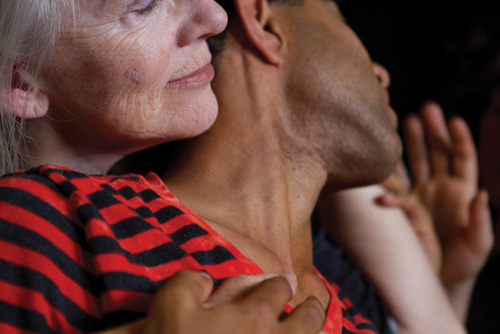arts@sfbg.com
DANCE Deborah Slater Dance Theater celebrated its 20th anniversary last year; for the Margaret Jenkins Dance Company, 2011 is its 38th season. The two choreographers have had enviable careers both locally and nationally. By now they know what they are doing. Or do they? Are there roads not yet taken?
Talking with both of them on the eve of their latest premieres — Slater’s Night Falls October 21 at ODC Theater, Jenkins’ Light Moves November 3 at Yerba Buena Center for the Arts — it is striking about how enthusiastic they are about the unknown. At this point in the rehearsal process they have an idea where the new pieces are going, yet they are also conscious of how fragile, risky, and exciting this whole art-making endeavor still is — particularly when it involves new collaborators.
The two women have much experience working closely with dancers, writers, designers, and composers. They are particularly committed to soliciting, and acknowledging, the contributions that dancers make in developing the movement material. But here they are both stepping into unknown territory, pushing their processes into new dimensions.
In Night Slater takes on the subject of aging. It’s a particularly poignant topic for dancers who are considered over the hill by the time they are 40. As is her want, Slater has done her research. Besides doing a lot of reading, she hosted a series of get-togethers with women between 30 and 80 who discussed the subject from a kaleidoscope of perspectives — physical, emotional, social, psychological. They provided welcome information but also elevated the topic beyond the level of personal experience.
The biggest input, however, came from an old friend, playwright-director Julie Hébert, with whom Slater worked early in her career as a soloist. Though the two have never collaborated on a company project, they have had many fruitful conversations over the years. Hébert wrote the script for Night featuring a heroine, Peregrine, who (Hébert and Slater agreed) would be realized by two male and four female performers. Each one, says Slater, acts his or her own age.
Jenkins’ new collaborator is visual artist Naomie Kremer, whose paintings and multi-media work she has admired for years. Jenkins recognized its theatrical potential when she saw Kremer’s video set for the 2008 Berkeley Opera production of Bluebeard’s Castle. In a preview last year, the video environment for Light looked sometimes saturated with color but airy and always luminous — in part, perhaps, because video depends on direct, and not reflected light.
Collaborating with Kremer provided Jenkins, who calls herself hopelessly monolingual, with the opportunity of learning a “new language.” Kremer imposes strong visual rhythms and cadences on what she does; her art dances even on a flat canvass. So to create a piece about the trajectory of daylight as it changes while traveling from dawn to dusk, the two artists had to juxtapose two different kinetic languages.
So what are the particular challenges that Slater and Jenkins are facing in working with these new collaborators? For Slater it is the fact that only one of her performers is a trained dancer. Over the years, she always worked with dancers who express themselves well in words and movement. Actors, apparently, want to use movement on a one-to-one basis with words. The two mediums are different, Slater says, “but they are learning. It’s all coming together.”
Her fellow choreographer has experienced a similar shift in her idea-sharing process: “I have learned to be much more articulate and precise in communicating my observations,” Jenkins says. Night Falls and Light Moves sound like they just might be companion pieces. *
NIGHT FALLS
Fri/21-Sat/22 and Oct. 27-29, 8 p.m.; Sun/23 and Oct. 30, 2 p.m., $17-$20
ODC Theater
3153 17th St., SF
(415) 863-9834
LIGHT MOVES
Nov. 3-5, 8 p.m., $25-$30
Novellus Theater
Yerba Buena Center for the Arts
700 Howard, SF
(415) 978-2787

